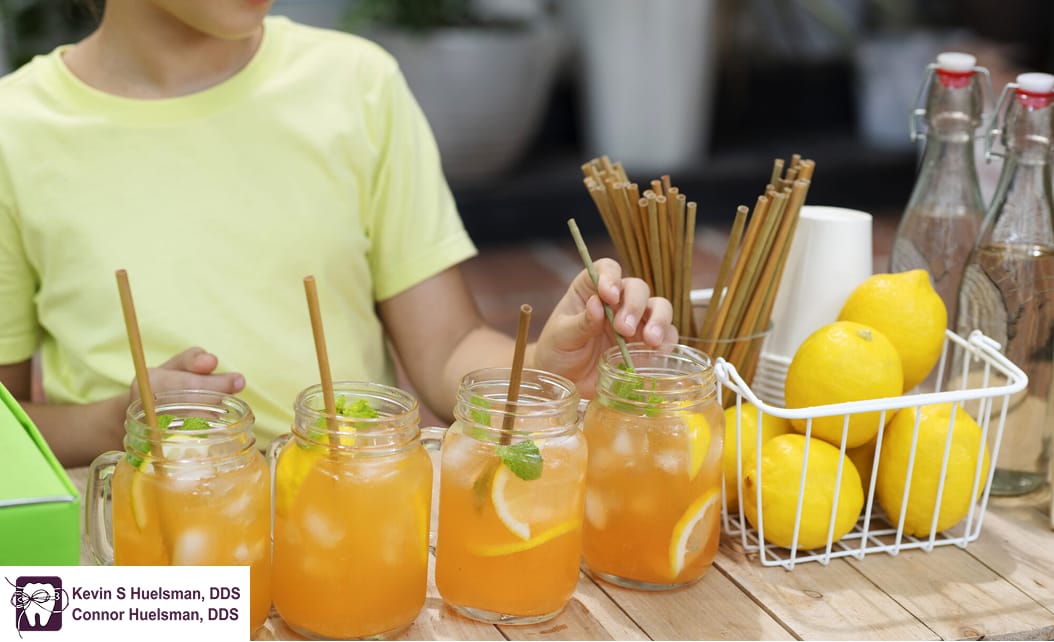
What Every Parent Should Know About Juice, Sugar, and Smiles
Every parent has stood in the juice aisle wondering if they’re making the right choice. Your kid wants the bright red fruit punch. You want something healthy. The dental hygienist’s voice echoes in your head about sugar and cavities.
Here’s the truth: juice isn’t great for teeth, but it’s not going to ruin your child’s smile overnight. Like most things in parenting, it’s about balance and smart choices. The good news? Once you understand how juice affects teeth, you can make decisions that work for your family without the guilt.
Understanding How Juice Affects Teeth
Kids love juice because it tastes good. Parents like it because it seems healthier than soda. Both perspectives make sense, and there’s no need to feel bad about either one.
The issue comes down to basic science. Juice contains sugar, and bacteria in your child’s mouth love sugar. When these bacteria eat sugar, they produce acid. That acid attacks tooth enamel and can eventually cause cavities.
But here’s what matters most: it’s not about being perfect. One juice box won’t destroy your child’s teeth. What matters is what happens most of the time, not once in a while. This shift in thinking can remove so much stress from daily parenting decisions.

Making Smarter Juice Choices
Now that you understand the basics, let’s talk about making better choices when you do buy juice. Walking down the juice aisle, you’ll see a huge range of options, and they’re definitely not all the same.
The worst choices are fruit cocktails and “juice drinks.” These are basically sugar water with artificial flavors and colors. They have little nutritional value but lots of sugar that feeds harmful bacteria.
Better choices are 100% fruit juices. They still contain natural sugar, but at least they provide vitamins and minerals, too. Your child gets some nutritional benefits along with the sweetness.
The best hack is dilution. Mix juice with water, starting with half juice and half water. Your kids probably won’t even notice the difference, and you just cut the sugar content in half. Over time, you can gradually add more water and less juice. Kids adapt to these changes faster than you might think.
Even fresh-squeezed juice, while it sounds fancy and healthy, is still sugar when it comes to your child’s teeth. Natural sugar behaves the same way as added sugar in the mouth.
Try making label reading a fun family activity. Help your kids spot juices with less added sugar. When they help choose healthier options, they’re more likely to drink them happily.
When and How Your Child Drinks Juice
Here’s something that might surprise you: how your child drinks juice matters just as much as what they drink. This is where you can make the biggest difference without changing what’s in your pantry.
The real problem isn’t necessarily the juice itself. It’s sipping it slowly throughout the day. When kids carry around a juice box for hours, their teeth get bathed in sugar and acid constantly.
Mouth bacteria need about 20 minutes to calm down after sugar hits them. If your child sips juice all afternoon, their mouth never gets a chance to recover and return to a healthy state.
Better timing makes all the difference. Give juice with meals instead of as an all-day drink. Eating increases saliva production, which helps wash away sugar and neutralize acid more quickly.
Simple fixes can help, too. Use a straw whenever possible. It helps juice bypass direct contact with teeth. Plus, most kids think drinking through straws is fun, so it’s an easy win.
Another simple strategy is encouraging water between meals and snacks. It rinses away leftover sugar and helps teeth recover from any acid exposure.

Practical Solutions That Actually Work
You need solutions that fit into real family life, not perfect scenarios that only work in theory. Here are some approaches that families consistently find helpful and sustainable.
Infused water is surprisingly popular with kids. Add cucumber slices, berries, or mint leaves to plain water. It looks fancy and tastes interesting without any added sugar. Many kids prefer this to plain water once they try it.
The 80/20 rule works beautifully for most families: offer water 80% of the time, and allow juice and other treats for the remaining 20%. This creates balance without making anyone feel completely deprived.
Make water exciting for your kids. Let them pick out a special water bottle in their favorite color. Add fun-shaped ice cubes. Create “spa water” with fruit slices that look pretty in the glass.
Incorporate a children’s dental checklist into your routine to cover all aspects of oral health, from regular brushing and flossing to scheduled dental checkups, ensuring a complete approach towards maintaining their healthy smiles.
The key is making gradual changes rather than dramatic overnight shifts. When kids feel involved in healthy choices instead of having restrictions imposed on them, they’re much more likely to embrace new habits.
Remember that building healthy habits takes time. Start with small changes and build from there. Your family will find its own rhythm.
Moving Forward With Confidence
Juice isn’t poison, but it’s not something to sip on all day either. Smart timing, simple dilution, and finding the right balance make all the difference for your child’s dental health.
Small changes really do add up over time. You don’t need to overhaul your entire kitchen or create stress around every food and drink choice.
Most importantly, asking these questions shows you care deeply about your child’s health. That caring attitude matters more than getting every single decision perfect.
If you’re concerned about your child’s teeth or want personalized advice, don’t hesitate to talk to your local dentist. They can give you specific guidance based on your family’s unique situation and your child’s individual needs.
Your child’s smile is absolutely worth protecting, and you’re already on the right track by thinking about these choices thoughtfully.
